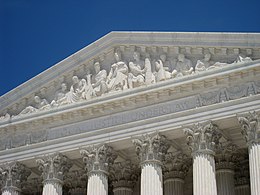Robert Ingersoll Aitken
Robert Ingersoll Aitken | |
|---|---|
San Francisco, California, US | |
| Died | January 3, 1949 (aged 70) |
| Known for | Sculpture |

Robert Ingersoll Aitken (May 8, 1878 – January 3, 1949) was an American sculptor. Perhaps his most famous work is the West Pediment of the United States Supreme Court Building.
Life and career
Born to Charles H. Aitken and Katherine A. Higgens[1] in San Francisco, California, Aitken studied there at the Mark Hopkins Institute of Art [also called the California School of Design – now the San Francisco Art Institute] with Douglas Tilden
During this period, Aitken in 1900 designed San Francisco's original municipal flag; the design was in use from 1900 until sometime in the early 1920s.[2]
In 1903, he sculpted the Victory figure for the top of the Dewey Monument, which still stands in San Francisco's Union Square.
In 1904, Aitken carved a 15-foot (4.6 m) statue of a female figure, representing the
In 1904, Aitken moved to Paris where he continued his studies. He returned to New York City after his sojourn in Paris and was employed as an instructor at the Art Students League. Eleanor Mary Mellon was among his pupils.[4]
His works include the Science fountain and Great Rivers statues at the
Perhaps his most famous work is the West
Aitken created a stir when he criticized the display and placement of the Venus de Milo.[6] His work was also part of the sculpture event in the art competition at the 1928 Summer Olympics.[7]
Medallic and coin design
See also
- George Rogers Clark(sculpture, 1921)
- Samuel Gompers Memorial
- Lumbermen Monument
- William A. Starke Memorial
References
- )
- ^ John Lumea, "The Original San Francisco Flag Was Better and Cooler. Let's Bring It Back!" September 12, 2018.
- ^ "McKinley Memorial, (sculpture)". Smithsonian Institution. Retrieved January 4, 2022.
- ISBN 978-1-135-63882-5.
- ^ "The West Pediment – Information Sheet" (PDF). Supreme Court of the United States. Retrieved March 17, 2007.
- New York Times. May 21, 1920. Retrieved January 30, 2011.
- ^ "Robert Ingersoll Aitken". Olympedia. Retrieved July 29, 2020.
Further reading
- Goode, James M. The Outdoor Sculpture of Washington, D.C., Smithsonian Institution Press, Washington, D.C., 1974
- Gurney, George, Sculpture and the Federal Triangle, Smithsonian Institution Press, Washington D.C., 1985
- Hunter, Marie Nau, Missouri and Mississippi: Robert Ingersoll Aitken's Sculpture in Jefferson City, Missouri, Master's Thesis, University of Missouri-Columbia, 1996
- Opitz, Glenn B, Editor, Mantle Fielding’s Dictionary of American Painters, Sculptors & Engravers, Apollo Book, Poughkeepsie, NY, 1986
- Proske, Beatrice Gilman, Brookgreen Gardens Sculpture, Brookgreen Gardens, South Carolina, 1968
